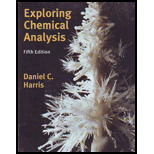
(a)
Interpretation:
Reason behind the formation of more theoretical plates per meter than thick film has to be explained.
Concept Introduction:
Plate height can be calculated by van Deemter equation as follows:
Here
The term
The term
The term
Number of theoretical plates is calculated as follows:
Here,
(a)
Explanation of Solution
Particle size has a significant impact on the analyte band. For smaller sized particles at very low flow rate the second term in the van Deemter equation is high but other two terms are small so plate height is not high enough. At high flow rate, the third term cannot play significant role as it is proportional to the square of the particle size thus, the value of third term is not high enough. So the summation of all three terms is small. Hence plate height is low.
For lager sized particles at very low flow rate, second term in the van Deemter equation will be predominant, hence at low flow rate plate height is high. And at high flow rate, third term in the equation is predominant as it is proportional to the square of the particle size. So plate height is high.
Hence it can be concluded that in general pate height of thin films is greater than that of thick films because particle size in thin film is smaller than that of thick film.
As number of theoretical plates is inversely proportional to plate height hence number of theoretical plates is higher in case of this film.
(b)
Interpretation:
Mass of stationary phase in each column has to be calculated.
Concept Introduction:
Formula to calculate volume of stationary phase is calculated as follows:
(b)
Explanation of Solution
For narrow bore column mass of stationary phase is
For narrow bore open tubular gas chromatography plate height is calculated as follows:
The volume of stationary phase is calculated as follows:
Mass of stationary phase is calculated as follows:
For wide bore open tubular gas chromatography plate height is calculated as follows:
The volume of stationary phase is calculated as follows:
Mass of stationary phase is calculated as follows:
For narrow bore column mass of stationary phase is
(c)
Interpretation:
Mass of analyte can be injected has to be calculated.
Concept Introduction:
Refer to part (b).
(c)
Answer to Problem 22.4P
For narrow bore column
Explanation of Solution
For narrow bore open tubular gas chromatography plate height is calculated as follows:
The volume of stationary phase is calculated as follows:
Mass of stationary phase is calculated as follows:
Mass of analyte can be injected is calculated as follows:
For wide bore open tubular gas chromatography plate height is calculated as follows:
The volume of stationary phase is calculated as follows:
Mass of stationary phase is calculated as follows:
Mass of analyte can be injected is calculated as follows:
For narrow bore column
Want to see more full solutions like this?
Chapter 22 Solutions
EBK EXPLORING CHEMICAL ANALYSIS
- Show the mechanism steps to obtain the lowerenergy intermediate: *see imagearrow_forwardSoap is made by the previous reaction *see image. The main difference between one soap and another soap isthe length (number of carbons) of the carboxylic acid. However, if a soap irritates your skin, they mostlikely used too much lye.Detergents have the same chemical structure as soaps except for the functional group. Detergentshave sulfate (R-SO4H) and phosphate (R-PO4H2) functional groups. Draw the above carboxylic acidcarbon chain but as the two variants of detergents. *see imagearrow_forwardWhat are the reactions or reagents used? *see imagearrow_forward
- The two pKa values of oxalic acid are 1.25 and 3.81. Why are they not the same value? Show the protontransfer as part of your explanation. *see imagearrow_forwardасть Identify all the bonds that gauche interact with C-OMe in the most stable conformation of the above compound.arrow_forwardPredict the reactants used in the formation of the following compounds using Acid-Catalyzed dehydration reactionarrow_forward
- Can I please get help with this?arrow_forward.. Give the major organic product(s) for each of the following reactions or sequences of reactions. Show ll relevant stereochemistry [3 ONLY]. A H Br 1. NaCN 2 NaOH, H₂O, heat 3. H3O+ B. CH₂COOH 19000 1. LiAlH4 THF, heat 2 H₂O* C. CH Br 1. NaCN, acetone 2 H3O+, heat D. Br 1. Mg. ether 3. H₂O+ 2 CO₂ E. CN 1. (CH) CHMgBr, ether 2 H₂O+arrow_forwardAssign this COSY spectrumarrow_forward
 ChemistryChemistryISBN:9781305957404Author:Steven S. Zumdahl, Susan A. Zumdahl, Donald J. DeCostePublisher:Cengage Learning
ChemistryChemistryISBN:9781305957404Author:Steven S. Zumdahl, Susan A. Zumdahl, Donald J. DeCostePublisher:Cengage Learning ChemistryChemistryISBN:9781259911156Author:Raymond Chang Dr., Jason Overby ProfessorPublisher:McGraw-Hill Education
ChemistryChemistryISBN:9781259911156Author:Raymond Chang Dr., Jason Overby ProfessorPublisher:McGraw-Hill Education Principles of Instrumental AnalysisChemistryISBN:9781305577213Author:Douglas A. Skoog, F. James Holler, Stanley R. CrouchPublisher:Cengage Learning
Principles of Instrumental AnalysisChemistryISBN:9781305577213Author:Douglas A. Skoog, F. James Holler, Stanley R. CrouchPublisher:Cengage Learning Organic ChemistryChemistryISBN:9780078021558Author:Janice Gorzynski Smith Dr.Publisher:McGraw-Hill Education
Organic ChemistryChemistryISBN:9780078021558Author:Janice Gorzynski Smith Dr.Publisher:McGraw-Hill Education Chemistry: Principles and ReactionsChemistryISBN:9781305079373Author:William L. Masterton, Cecile N. HurleyPublisher:Cengage Learning
Chemistry: Principles and ReactionsChemistryISBN:9781305079373Author:William L. Masterton, Cecile N. HurleyPublisher:Cengage Learning Elementary Principles of Chemical Processes, Bind...ChemistryISBN:9781118431221Author:Richard M. Felder, Ronald W. Rousseau, Lisa G. BullardPublisher:WILEY
Elementary Principles of Chemical Processes, Bind...ChemistryISBN:9781118431221Author:Richard M. Felder, Ronald W. Rousseau, Lisa G. BullardPublisher:WILEY





